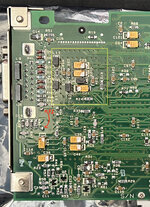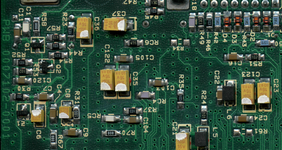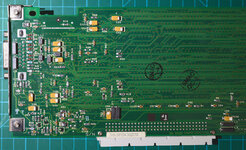I tested all resistors using a multimeter and got reasonable resistance measurements except for a handful of them, and I replaced those with new resistors and so all the resistors are good now.
I tested the resistance on all the capacitors and found 8 of them which were suspect (super high resistance in the millions or my multimeter was saying it was open). I tested all the capacitors with my ESR meter as well and since I don't have the specs for the caps, I can't correctly interpret the results but my ESR meter was saying 7 of the capacitors had suspicious values, all 7 were part of the 8 I found with suspicious resistance measurements. What do I mean by suspicious for my resistance measurements? All the other caps were returning resistance values in the hundreds or thousands. These 8 were the only ones that were either open or in the millions.
So I pulled all 8 of these capacitors. And here are some of the measurements with the capacitor
removed from the board. For each of these, note that I did try measuring both directions just in case.
- C4 (bottom side) - 45nF reading (probably a 50nF), bad ESR, 30M+ resistance
- C7 (bottom side) - 45nF reading (probably a 50nF), bad ESR, OL on resistance
- C120 (bottom side) - 96nF reading (probably a 100nF), bad ESR, 20M+ resistance
- C15 (bottom side) - 100nF reading, bad ESR, 20M+ resistance
- C124 (bottom side) - 10nF reading, ESR meter says OPEN, 30M+ resistance
- C10 (top side) - 50nF reading, bad ESR, OL on resistance
- C5 (top side) - 1uF reading, good ESR, OL on resistance?? confused about this one
- C13 (top side) - can't get a capacitance reading, ESR meter says OPEN, 20M+ resistance
I want to try replacing each of these capacitors but not sure if I fully trust the capacitance readings. Wish these things had identifiers on them. Not even sure what the significance of the colors on them are. Most of them are a light brown. Some are gray. Some are darker brown. Go figure. And I'm missing the reading on the C13 which obviously looks dead.
Also confused about the board markings ... resistors start with an
R, and capacitors start with a
C. Transistors look to start with a
Q. And regular diodes begin with an
L. The orange diodes (marked with a
D) seem to be Zener diodes?
But the ones I don't understand are the components labeled with an
RC. If you look at my most recent high resolution picture, lower middle of the board, about an inch to the right of the monitor port, you will see
RC6 and also an
RC4. The
RC6 clearly is labeled like a resistor. But
RC4 is not labeled and looks like a capacitor. Huh??



